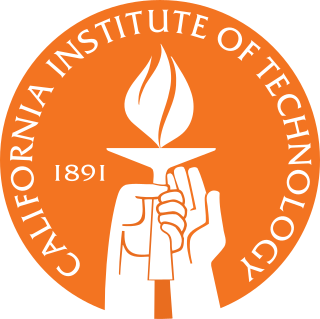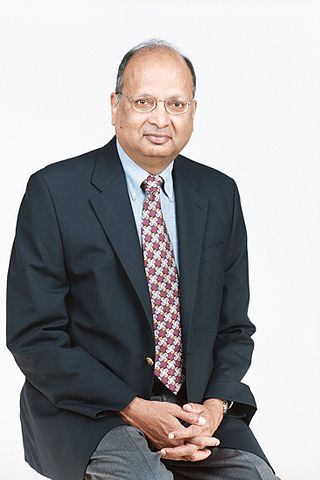Related Research Articles

The California Institute of Technology (branded as Caltech) is a private research university in Pasadena, California. The university is responsible for many modern scientific advancements and is among a small group of institutes of technology in the United States that are strongly devoted to the instruction of pure and applied sciences. Due to its history of technological innovation, Caltech has been considered to be one of the world's most prestigious universities.

Sir William Ramsay was a Scottish chemist who discovered the noble gases and received the Nobel Prize in Chemistry in 1904 "in recognition of his services in the discovery of the inert gaseous elements in air" along with his collaborator, John William Strutt, 3rd Baron Rayleigh, who received the Nobel Prize in Physics that same year for their discovery of argon. After the two men identified argon, Ramsay investigated other atmospheric gases. His work in isolating argon, helium, neon, krypton, and xenon led to the development of a new section of the periodic table.

Pulickel Madhavapanicker Ajayan, known as P. M. Ajayan, is the Benjamin M. and Mary Greenwood Anderson Professor in Engineering at Rice University. He is the founding chair of Rice University's Materials Science and NanoEngineering department and also holds joint appointments with the Department of Chemistry and Department of Chemical and Biomolecular Engineering. Prior to joining Rice, he was the Henry Burlage Professor of Material Sciences and Engineering and the director of the NYSTAR interconnect focus center at Rensselaer Polytechnic Institute until 2007. Known for his pioneering work of designing and carrying out the first experiments to make nanotubes intentionally.

Arogyaswami J. Paulraj is an Indian-American electrical engineer, academic. He is a Professor Emeritus in the Dept. of Elect. Engg. at Stanford University.

John Leonard Anderson is the current president of the National Academy of Engineering. He was a professor of chemical engineering, who served as the eighth president of Illinois Institute of Technology. Prior to his appointment at IIT, Anderson held positions in academia at various institutions, serving both as the provost of Case Western Reserve University and the dean of the College of Engineering at Carnegie Mellon University.

Subra Suresh is an Indian-born American engineer, materials scientist, and academic leader. He is currently Professor at Large at Brown University and Vannevar Bush Professor of Engineering Emeritus at the Massachusetts Institute of Technology (MIT). He was Dean of the School of Engineering at MIT from 2007 to 2010 before being appointed as Director of the National Science Foundation (NSF) by Barack Obama, where he served from 2010 to 2013. He was the president of Carnegie Mellon University (CMU) from 2013 to 2017. Between 2018 and 2022, he was the fourth President of Singapore's Nanyang Technological University (NTU), where he was also the inaugural Distinguished University Professor.

Manchanahalli Rangaswamy Satyanarayana Rao was an Indian scientist. He was awarded the fourth-highest civilian award, the Padma Shri, for Science and Engineering in 2010. From 2003 to 2013 he was president of Jawaharlal Nehru Centre for Advanced Scientific Research (JNCASR) in Bangalore, India.

Jan Drewes Achenbach was a professor emeritus at Northwestern University. Achenbach was born in the northern region of the Netherlands, in Leeuwarden. He studied aeronautics at Delft University of Technology, which he finished with a M.Sc. degree in 1959. Thereafter, he went to the United States, Stanford University, where he received his Ph.D. degree in 1962. After working for a year as a preceptor at Columbia University, he was then appointed as assistant professor at Northwestern University.
The American Indian Science and Engineering Society (AISES) is a 501(c)(3) non-profit professional association with the goal of substantially increasing American Indian, Alaskan Native, Native Hawaiian, Pacific Islander, First Nation and other indigenous peoples of North America representation in the fields of science, technology, engineering, math (STEM) and other related disciplines. Its headquarters is located in Albuquerque, New Mexico. As of May 1, 2013, Sarah EchoHawk is the Chief Executive Officer.

Mary Golda Ross was the first Native American female engineer. She was also the first female engineer in the history of the Lockheed Corporation. She worked at Lockheed from 1942 until her retirement in 1973, where she was best remembered for her work on aerospace design. She was one of the 40 founding engineers of the renowned and highly secretive Skunk Works project while at Lockheed Corporation. Throughout her life, Ross was dedicated to the advancement of young women and Native Americans in STEM fields. Ten years after her death, in 2018, Ross was chosen to be depicted on the 2019 Native American $1 Coin by the U.S. Mint celebrating Native Americans in the space program.
Arcot Ramachandran (1923-2018) was an Indian scientist, anthropologist, author and a former Under-Secretary General of United Nations Centre for Human Settlements, known for his scholarship on the subjects of heat and mass transfer and environment and his social commitment to the cause of sustainable development. The Government of India honoured him in 2003, with the Padma Bhushan, the third highest civilian award, for his services to the fields of Science and Engineering.

Bulusu Lakshmana Deekshatulu is an Indian academic who has made important contributions to Digital Image Processing and Control Theory. He is a Fellow of The World Academy of Sciences, Fellow of Indian National Science Academy, The National Academy of Sciences, India, Indian Academy of Sciences, Indian National Academy of Engineering, National Academy of Agricultural Sciences, and IEEE.

Nancy Beth Jackson was an American chemist. She did energy research on heterogeneous catalysis and the development of alternative fuels. She also worked in the field of chemical nonproliferation, educating chemical professionals on the importance of safe and secure chemical practice in research, teaching and business, in an effort to prevent the misuse of chemicals as "weapons, poisons, explosives or environmental pollutants". She was the first implementer in developing the international Chemical Security Engagement Program. She was active in promoting diversity in STEM fields. She was president of the American Chemical Society in 2011, leading the organization during the International Year of Chemistry. In 2012, she was honored with the AAAS Award for Science Diplomacy.
Bhakta B. Rath is an Indian American material physicist and head of the Materials Science and Component Technology of the United States Naval Research Laboratory (NRL), the corporate research laboratory for the United States Navy and the United States Marine Corps. He is the chief administrative officer for program planning, interdisciplinary coordination, supervision and control of research and is the associate director of research for Materials Science and Component Technology at NRL.
Carol Gardipe is an American geologist, whose career has included positions with the United States Geological Survey (USGS), National Oceanic and Atmospheric Administration, and roles in higher education as a professor and administrator. She is one of the seven founders of the American Indian Science and Engineering Society (AISES).
Karletta Chief is a Diné hydrologist, best known for her work to address environmental pollution on the Navajo Nation and increase the participation of Native Americans in STEM. She is a professor at the University of Arizona.

Aaron Yazzie is a Diné (Navajo) mechanical engineer at NASA's Jet Propulsion Laboratory. His work involves planetary sample acquisition and handling. He has worked on the Mars Science Laboratory, InSight, and Mars 2020 missions.
Jerry Chris Elliott High Eagle is a physicist and was one of the first Native Americans who worked at NASA. He is most known for his contributions as the lead retrofire officer during Apollo 13, where his actions saved the lives of the three astronauts on board. Elliott's work awarded him the Presidential Medal of Freedom, the highest civilian honor awarded by the President of the United States.
Sandra K. Begay is an American/Navajo Nation mechanical engineer who designs research and development systems at Sandia National Laboratories in Albuquerque, New Mexico. In 2020, she was honored by the American Indian Science and Engineering Society's Indigenous Excellence Award. She is known for her work expanding energy access through alternative and renewable solutions for remote tribal members on the Navajo Reservation.
Freda Porter, a member of the Lumbee Tribe of North Carolina, is an applied mathematician and environmental scientist known as one of the first Native American women to earn a PhD in the mathematical sciences. She is the president and CEO of Porter Scientific, Inc. and president of Lumbee Tribe Enterprises, LLC.
References
- ↑ Landon, Chris R. (1993). "American Indian Contributions To Science and Technology" (PDF). Portland Public Schools. Archived from the original (PDF) on 2008-10-29. Retrieved 2010-07-13.
- ↑ American Indian Science and Engineering Society - About Us Archived July 7, 2010, at the Wayback Machine
- ↑ aises-admin (2018-11-14). "Our History". AISES. Retrieved 2019-04-18.